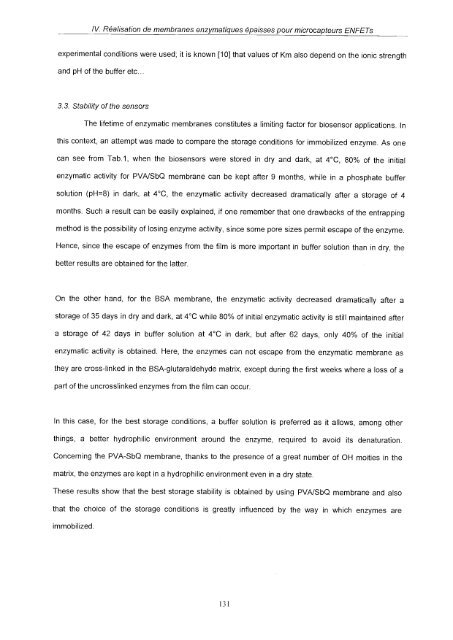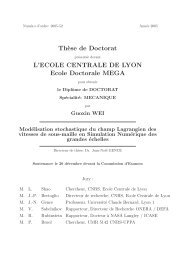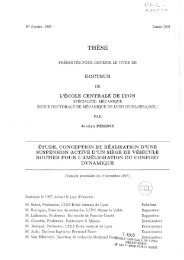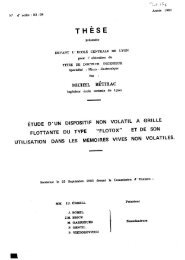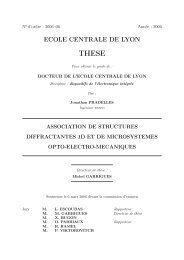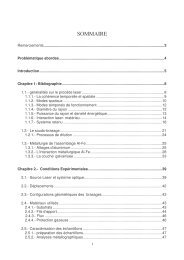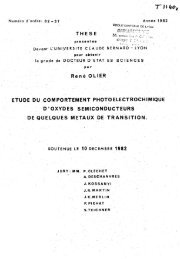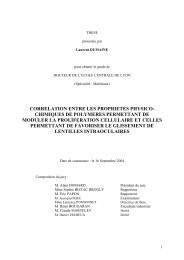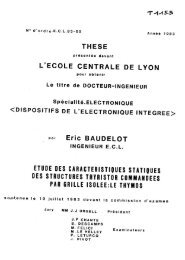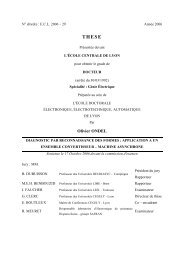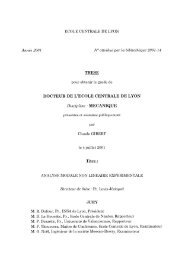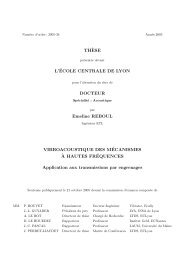Etude de différentes méthodes de biofonctionnalisation pour la ...
Etude de différentes méthodes de biofonctionnalisation pour la ...
Etude de différentes méthodes de biofonctionnalisation pour la ...
Create successful ePaper yourself
Turn your PDF publications into a flip-book with our unique Google optimized e-Paper software.
IV, Réalisation <strong>de</strong> membranes enzymatiques épaisses <strong>pour</strong> microcapteurs ENFETs<br />
experimental conditions were used; ¡t is known [10] that values of Km also <strong>de</strong>pend on the ionic strength<br />
and pH of the buffer etc..<br />
3.3. Stability of the sensors<br />
The lifetime of enzymatic membranes constitutes a limiting factor for biosensor applications. In<br />
this context, an attempt was ma<strong>de</strong> to compare the storage conditions for immobilized enzyme. As one<br />
can see from Tab.1, when the biosensors were stored in dry and dark, at 4°C, 80% of the initial<br />
enzymatic activity for PVNSbQ membrane can be kept after 9 months, while in a phosphate buffer<br />
solution (pH=8) in dark, at 4°C, the enzymatic activity <strong>de</strong>creased dramatically after a storage of 4<br />
months. Such a result can be easily exp<strong>la</strong>ined, if one remember that one drawbacks of the entrapping<br />
method is the possibility of losing enzyme activity, since some pore sizes permit escape of the enzyme.<br />
Hence, since the escape of enzymes from the film is more important in buffer solution than in dry, the<br />
better results are obtained for the <strong>la</strong>tter.<br />
On the other hand, for the BSA membrane, the enzymatic activity <strong>de</strong>creased dramatically after a<br />
storage of 35 days in dry and dark, at 4°C while 80% of initial enzymatic activity is still maintained after<br />
a storage of 42 days in buffer solution at 4°C in dark, but after 62 days, only 40% of the initial<br />
enzymatic activity is obtained, Here, the enzymes can not escape from the enzymatic membrane as<br />
they are cross-linked in the BSA-glutaral<strong>de</strong>hy<strong>de</strong> matrix, except during the first weeks where a loss of a<br />
part of the uncrosslinked enzymes from the film can occur.<br />
In this case, for the best storage conditions, a buffer solution is preferred as it allows, among other<br />
things, a better hydrophilic environment around the enzyme, required to avoid its <strong>de</strong>naturation.<br />
Concerning the PVA-SbQ membrane, thanks to the presence of a great number of OH moities in the<br />
matrix, the enzymes are kept in a hydrophilic environment even in a dry state.<br />
These results show that the best storage stability is obtained by using PVNSbQ membrane and also<br />
that the choice of the storage conditions is greatly influenced by the way in which enzymes are<br />
immobilized.<br />
131


